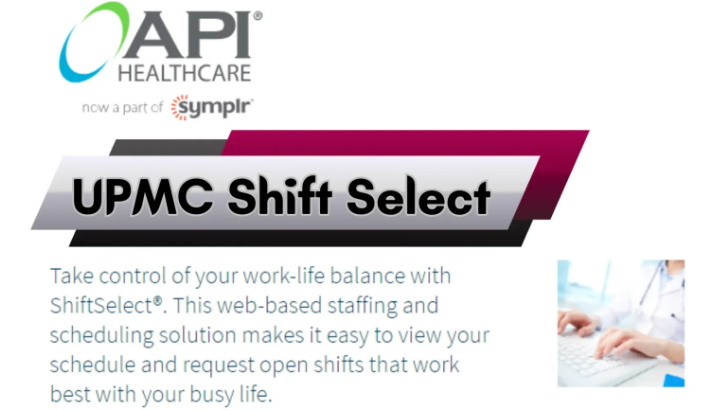Introduction
Set up in 1893, the College of Pittsburgh Restorative Center (UPMC) has developed as a worldwide pioneer in healthcare and restorative investigation. Over its long and distinguished history, UPMC has ceaselessly pushed the boundaries of development, setting unused benchmarks for understanding care and restorative fabulousness. In this comprehensive article, we dive into the multifaceted operations of UPMC, centering on its groundbreaking UPMC Shift Select system—a progressive stage outlined to convert workforce administration and upgrade operational efficiency.
The Distinction of UPMC
UPMC’s broad organization includes more than 40 healing centers, 700 doctors’ workplaces and outpatient locales, and a tremendous group of over 8,500 doctors. This broad foundation empowers UPMC to serve millions of patients yearly over Pennsylvania and past, giving a comprehensive extend of administrations traversing essential care to profoundly specialized medications such as cancer care, transplantation, neurosurgery, and more.
Digging into UPMC Shift Select
Central to UPMC’s operations is the UPMC Shift Select platform. It’s a modern scheduling system designed to improve workforce management and enhance employee satisfaction. Unlike traditional methods, this system uses advanced technology to simplify scheduling processes. UPMC Shift Select employs algorithms and data analysis to efficiently assign staff based on factors like employee preferences and workload demands. This helps prevent staffing issues that can affect patient care. Employees also benefit from greater control over their schedules. They can indicate their availability, preferred shifts, and time-off requests through an easy-to-use interface. This flexibility improves work-life balance and boosts morale. The platform also features real-time monitoring and communication tools, enabling managers to quickly address scheduling conflicts or changes.
Opening the Benefits of UPMC Shift Select
UPMC Shift Select engages workers by giving them more noteworthy control over their plans. Through an natural online interface, staff individuals can easily get to accessible shifts, ask time off, and lock in in consistent move swapping with their peers. This adaptability not as it were advances a more advantageous work-life adjustment but too cultivates a sense of independence and strengthening among workers, eventually driving to expanded assurance and productivity.
Also Read: Korps Sukarela ( KSR ): Building Resilience Through Volunteerism

Upgrading Representative Empowerment
By involving employees in decision-making processes, UPMC fosters a culture of collaboration and empowerment within its workforce. This inclusive approach not only boosts employee morale but also nurtures a sense of ownership and accountability, leading to a more engaged and motivated workforce. Ultimately, this translates into improved patient care delivery and better clinical outcomes.
Employees who feel valued and respected are more likely to be invested in their work and committed to achieving organizational goals.By soliciting input from frontline staff in planning decisions, UPMC ensures that the perspectives and insights of those directly involved in patient care are considered. This collaborative approach enables UPMC to identify areas for improvement and implement changes that resonate with employees, ultimately enhancing workplace satisfaction and fostering a positive organizational culture.
Moreover, by empowering employees to actively participate in decision-making processes, UPMC creates a sense of ownership and responsibility among staff members. When employees feel that their opinions are valued and their contributions are recognized, they are more likely to take initiative, demonstrate accountability, and strive for excellence in their roles. This heightened sense of ownership not only strengthens employee engagement but also cultivates a culture of continuous improvement and innovation within the organization.
As a result of this collaborative and empowering approach, UPMC is able to deliver higher quality patient care, with staff members who are dedicated, motivated, and committed to providing the best possible outcomes for patients. By leveraging the collective expertise and insights of its workforce, UPMC enhances its ability to address complex healthcare challenges, adapt to changing patient needs, and deliver value-based care that positively impacts patient outcomes.
Driving Operational Productivity through Data-Driven Insights
Furthermore, UPMC provides administrators with valuable data-driven insights to optimize resource allocation and staffing levels. Leveraging real-time information and demand forecasting capabilities, UPMC can adjust staffing levels proactively to efficiently meet patient needs. This approach minimizes wait times, reduces operational costs, and enhances overall service quality. Administrators can utilize this information to make informed decisions, ensuring that resources are allocated effectively to support patient care while maintaining operational efficiency.
UPMC’s Commitment to Instruction, Investigate, and Innovation
Past its operational greatness, UPMC is eminent for its unflinching commitment to instruction, inquiry about, and advancement. As a scholastic therapeutic center partnered with the College of Pittsburgh, UPMC plays an essential part in forming the long run healthcare through its comprehensive instructive programs and groundbreaking investigation activities. Collaborative endeavors between UPMC and the University’s Schools of the Wellbeing Sciences make an environment where advancement flourishes, driving to headways in quiet care and therapeutic research.
Conclusion
In conclusion, the College of Pittsburgh Therapeutic Center stands as a signal of brilliance in healthcare, driven by its commitment to development, instruction, and patient-centered care. UPMC Shift Select represents UPMC’s commitment to upgrading operational effectiveness and representative fulfillment, eventually guaranteeing the conveyance of high-quality care to each understanding, each day.


